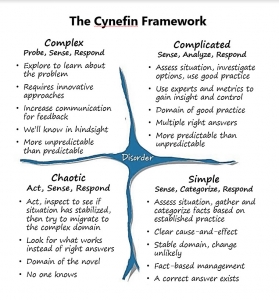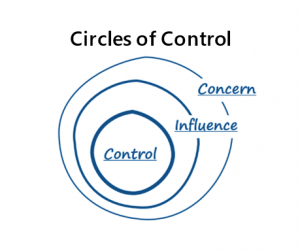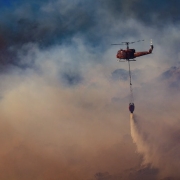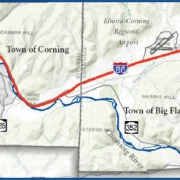“We want desperately to take the uncertainty out of the future. But when we take the uncertainty out, it is no longer the future. It is the present projected forward.”
–Peter Block from
Community: The Structure of Belonging
By Abby Straus
We are living in exciting and challenging times. Until recently, strategic planning during a global pandemic would have been unthinkable; yet here we are making the best of it as folks on a mission to create a bright future for our organizations and their people. As well as COVID 19, we are experiencing unprecedented rates of technological and social change, some of which—like a new awareness of systemic racism—are rocking the very foundations of American society. We are fortunate to stand on the shoulders of academics and practitioners who have studied this brand of volatility, uncertainty, complexity, and ambiguity (known as “VUCA”) and who have developed frameworks that help us navigate such unfamiliar and changing terrain.
One thing we know for sure: In light of accelerating rate of change, we can no longer create static plans where we invest large amounts of energy up front and then simply implement. Rather, we must work from first principles that we know will stand the test of time, and then build strategies and action plans, revisiting them frequently, and testing them for relevance and feasibility. We must establish dynamic control by using a probe-sense-respond methodology, where we try new things, feed what works and remove resources from what does not. We must be adaptable in our thinking as well as our action and be willing to pivot when the situation demands.
That having been said, as organizations with jobs to perform, we need concrete direction for how to proceed day-to-day. Here are some tools that support us in understanding the territory and creating a roadmap to the future we desire.
Tools for Navigating VUCA
The Cynefin Framework
 The Cynefin (pronounced Kin-e-vin) framework, created by complex systems expert Dave Snowden, helps us understand the thinking and action necessary to deal with VUCA. Much of traditional planning lives in the right-hand quadrants and is based on the premise that the future will be enough like today that we can successfully meet our challenges and opportunities by relying on what is known and the advice of experts.
The Cynefin (pronounced Kin-e-vin) framework, created by complex systems expert Dave Snowden, helps us understand the thinking and action necessary to deal with VUCA. Much of traditional planning lives in the right-hand quadrants and is based on the premise that the future will be enough like today that we can successfully meet our challenges and opportunities by relying on what is known and the advice of experts.
For some time now, however, we have been living in complexity (upper left quadrant) surrounded by unpredictability and rapid change. Add COVID 19, and we are catapulted into totally novel, or chaotic, situations (lower left) where it is impossible to tell with any certainty what the future will bring. Will libraries once again be places where people gather? How might services have to change to address the new needs of communities? What will happen to budgets? To jobs? To the health of our citizens? Will there be a “new normal” and, if so, what will it be?
In this environment, we can only speculate about what will happen next. Therefore, the action we take must be based on a very different kind of thinking. We must cultivate a high tolerance for uncertainty and the means to try new things. This will undoubtedly involve creating new organizational structures to maximize adaptability and minimize red tape, so that we can quickly, and with the least resistance, develop and implement novel solutions to challenges as they arise.
Will we still operate in the simple and complicated domains where best practices and the advice of experts suffice? Of course we will; but we must also become good at navigating the complex and, if recent history is a guide, the chaotic dimensions as well in order to develop the agility necessary to thrive today and tomorrow.
Scenario Planning
Scenario Planning is an activity we can engage in to use what we know today to imagine and plan for the future. This framework consists of four steps:
- Identify driving forces: What is going on in our world (society, economics, technology, etc.) that is having or will have a big effect on our organization
- Identify critical uncertainties: Which two to three of these will have the most influence on your organization?
- Develop plausible scenarios: How might these uncertainties combine? Develop up to four scenarios describing what might happen.
- Discuss the implications: How will these scenarios affect your organization, it’s mission and strategy?
It is important to remember that we cannot predict the future; we can only develop a sense of what might happen based on the knowledge we have now. This process is particularly useful when we have clear trends to work with, the increasing use of online platforms, for example, or the certain demise of an industry. When we have less definitive information, it is frequently wiser to use techniques to help us understand the kind of adaptive capacity we need to build in order to address a range of eventualities. One way to do this is to use the four-step environmental scan described below.
Environmental Scan
- What can we control that affects performance and outcomes?

- What can we influence (outside our sphere of control) that affects performance and/or outcomes?
- What are we concerned about in our environment (outside our spheres of control or influence) that affects performance and/or outcomes?
- How can we adapt our strategy and/or actions to take advantage of the opportunities and manage the risks identified in this environmental scan?
KAIR or Dynamic SWOT
Keep-Abandon-Invent-Reinvent (KAIR) is a process we developed for exploring how to create positive change. You can use it as an individual, in a team, or throughout an organization. It is a dynamic, adaptive version of the traditional Strengths, Weaknesses, Opportunities, Threats (SWOT) analysis that is both aspirational and generates immediate calls to action.
The tool has four parts:
- Keep strategies or activities that are working well
- Abandon strategies or activities that are a barrier to future success
- Invent new solutions that have not been previously considered
- Reinvent activities or solutions that could benefit from improvement
The KAIR process is useful for individuals, teams, and organizations, as an after action review or as part of a planning process.
All of these practices—and others—may be used together as part of an effort to get our minds and hands around our future. Regardless of the method we choose, it is vital to constantly uncover and test our assumptions. We must ask
As we said, the shift in thinking lies in learning to hold our plans lightly enough that we can allow change as it occurs rather than wasting energy with anything proven not to be viable. It takes some practice, but the rewards are huge. We can create our new path one step at a time by testing the ground as we go. In order to create the future, we must be able to dance with uncertainty, knowing that we have what it takes to navigate VUCA together.







Leave a Reply
Want to join the discussion?Feel free to contribute!